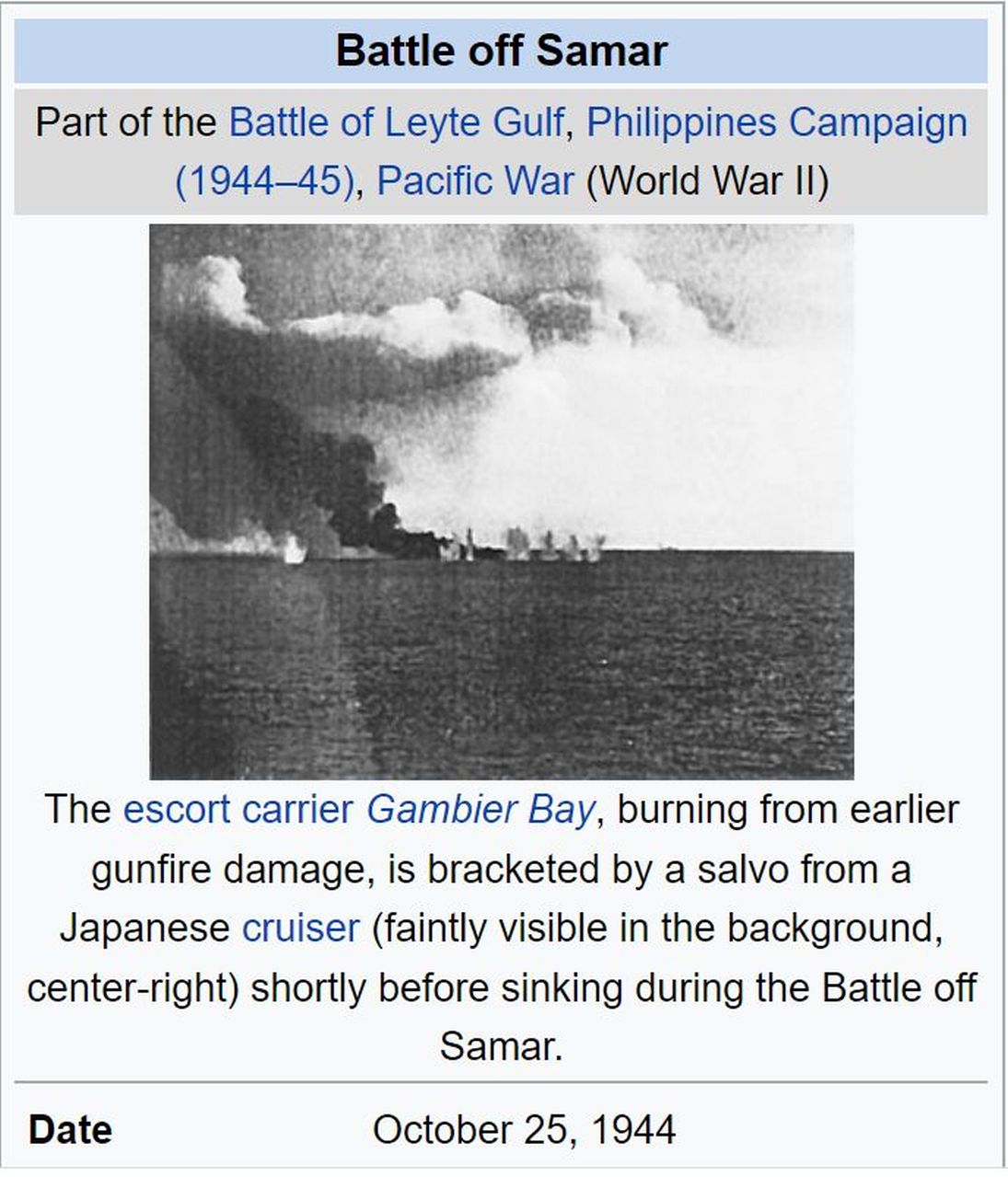
Zf759. The escort carrier Gambier Bay, burning from earlier gunfire damage, is bracketed by a salvo from a Japanese cruiser (faintly visible in the background, center-right) shortly before sinking during the Battle off Samar. This picture is from the Wikipedia page: “The Battle Off Samar”.
—————————————————————————
Survivors of the “Battle off Samar”.
Part of the Battle of Leyte Gulf,
Samar is full of History; this presentation is about the “Battle off Samar” and the survivors. I started to post this material here in Flickr because it allows one to post in high resolution. The NARA source is: https://catalog.archives.gov/id/80685150
I read up on the “Battle off Samar” in this Wikipedia URL and sprinkled this presentation with pictures and quotes from it: https://en.wikipedia.org/wiki/Battle_off_Samar
—————————————————————————-

Zf759. The escort carrier Gambier Bay, burning from earlier gunfire damage, is bracketed by a salvo from a Japanese cruiser (faintly visible in the background, center-right) shortly before sinking during the Battle off Samar. This picture is from the Wikipedia page: “The Battle Off Samar”.
The Battle off Samar was the centermost action of the Battle of Leyte Gulf, one of the largest naval battles in history, which took place in the Philippine Sea off Samar Island, in the Philippines on October 25, 1944. It was the only major action in the larger battle in which the Americans were largely unprepared. The Battle off Samar has been cited by historians as one of the greatest last stands in naval history; ultimately the Americans prevailed over a massive armada—the Imperial Japanese Navy‘s Center Force under command of Vice Admiral Takeo Kurita—despite their very heavy casualties and overwhelming odds.
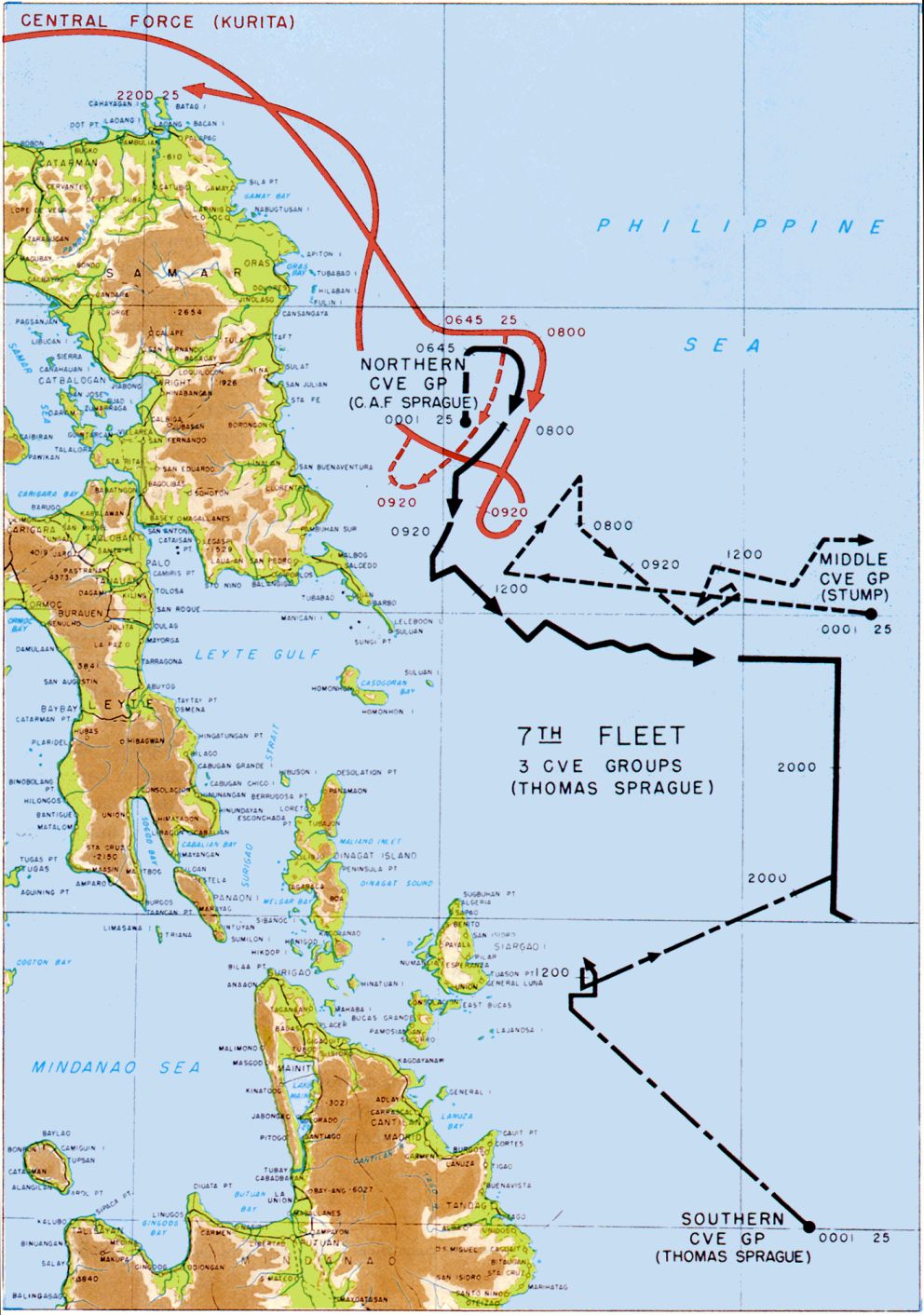
Zf760. Unit Movements during the battle off Samar which was part of the Battle of Leyte Gulf, Philippines Campaign (1944–45), Pacific War (World War II). This picture is from the Wikipedia page: “The Battle Off Samar”.
Admiral William Halsey Jr. was lured into taking his powerful Third Fleet after a decoy fleet of what was left of the Imperial Navy’s carrier force, including the last member of the Pearl Harbor attack, the aircraft carrier Zuikaku, taking with him every ship in the area that he had the power to command. The remaining American forces in the area were three escort carrier groups of the Seventh Fleet. The escort carriers and destroyer escorts which had been built to protect slow convoys from submarine attack had been adapted to attack ground targets and had few torpedoes, as they normally relied on Halsey’s fleet to protect them from armored warships.
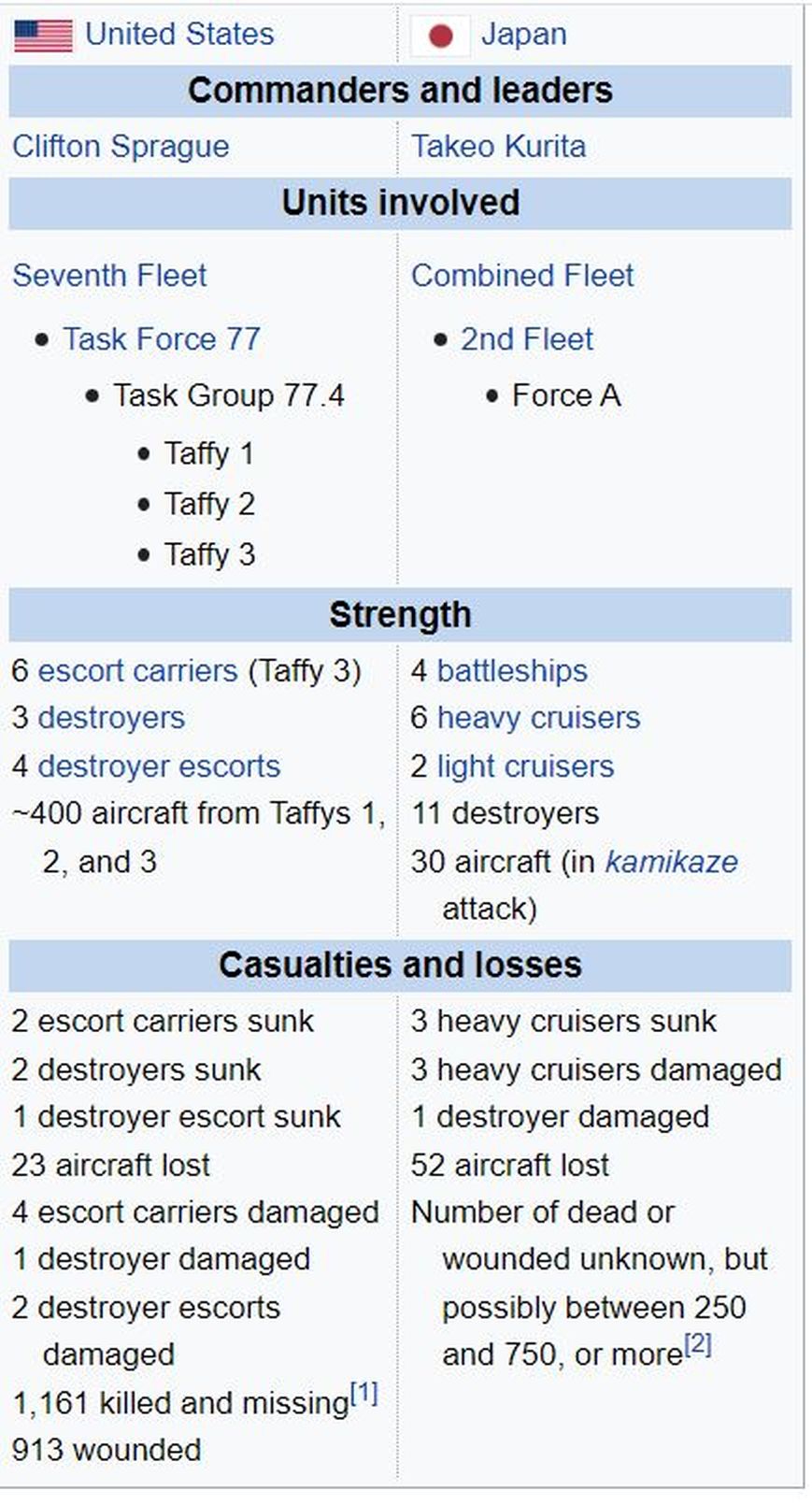
Zf761. Statistics and Data of the Battle OFF Samar. This picture is from the Wikipedia page: “The Battle Off Samar”.
A Japanese surface force of battleships and cruisers—led by the battleship Yamato, the largest and most heavily-gunned ship afloat—had been battered earlier in the larger battle and was thought to have been in retreat. Instead, it had turned around unobserved and encountered the northernmost of the three groups, Task Unit 77.4.3 (“Taffy 3”), commanded by Rear Admiral Clifton Sprague. Taffy 3’s three destroyers and four destroyer escorts possessed neither the firepower nor the armor to oppose the 23 ships of the Japanese force capped by the Yamato‘s 18.1-inch (46 cm) guns but attacked anyway with 5-inch (127 mm)/38 caliber guns and torpedoes to cover the retreat of their slow “jeep” carriers. Aircraft from the carriers of Taffys 1, 2, and 3, including FM-2 Wildcats, F6F Hellcats and TBM Avengers, strafed, bombed, torpedoed, rocketed, depth-charged and made numerous “dry” runs at the Japanese force when they ran out of ammunition.[3]
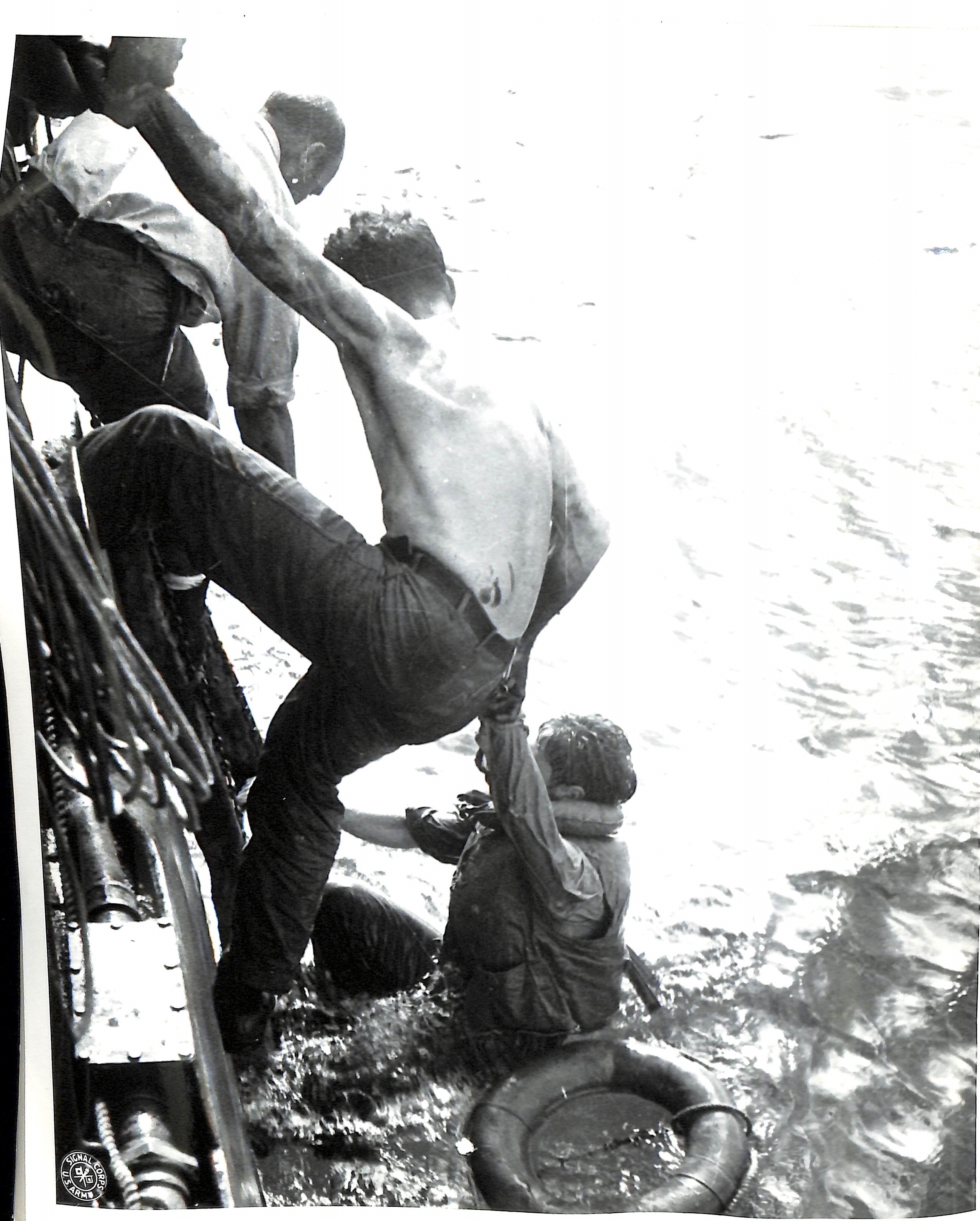
Zf762. A survivor/survivors of the Navy ships Gambier Bay, Hoel, Johnston, and Roberts is/are rescued. This is a NARA image.
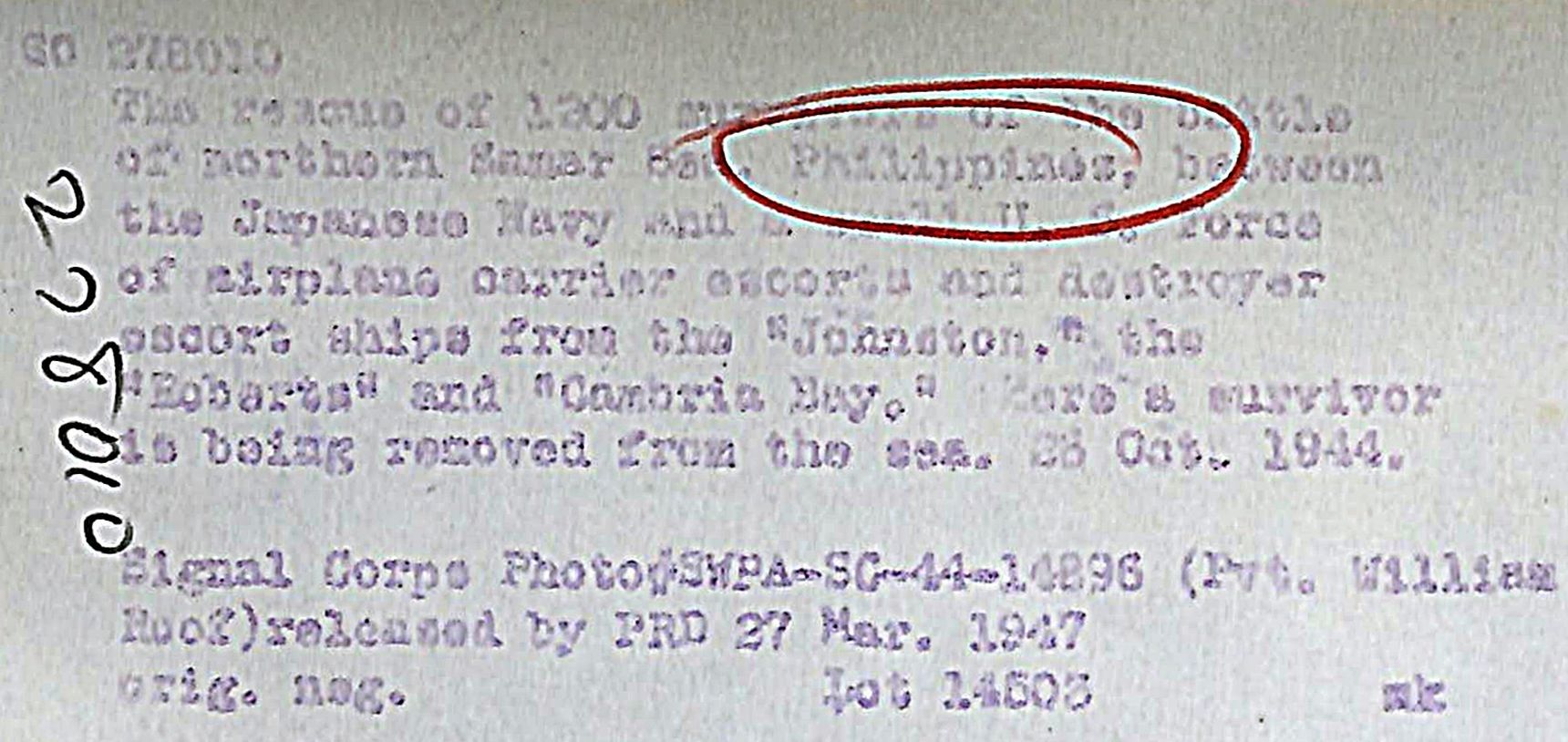
Zf763. This is the description of the previous image.
The force lost two escort carriers, two destroyers, a destroyer escort and several aircraft. Over a thousand Americans died, comparable to the combined losses of American men and ships at the Coral Sea and Midway. The Americans sank three Japanese cruisers, disabled another three and caused enough confusion to persuade Admiral Kurita to regroup and ultimately withdraw, rather than advancing to sink troop and supply ships in Leyte Gulf. Half of all Americans killed at Leyte Gulf were killed in the battle. Although the battleship Yamato and the remaining force returned to Japan, the battles marked the final defeat of the Imperial Japanese Navy, as the ships remained in port for most of the rest of the war and ceased to be an effective naval force.[4]
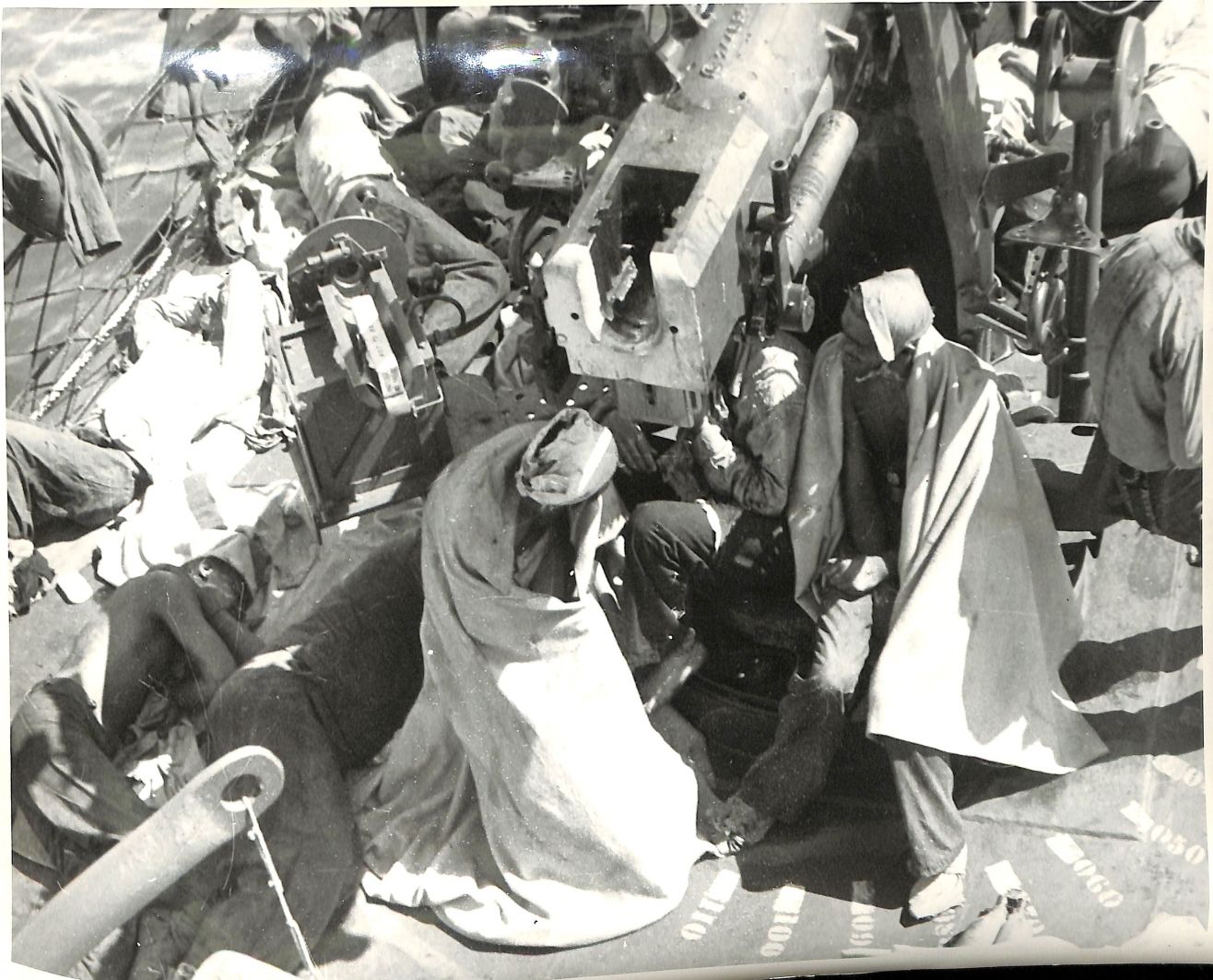
Zf764. A survivor/survivors of the Navy ships Gambier Bay, Hoel, Johnston, and Roberts is/are rescued. This is a NARA image.

Zf765. This is the description of the previous image.
On the night of October 23, the American submarines Dace and Darter detected Center Force entering the Palawan Passage. After alerting Halsey, the submarines torpedoed and sank two cruisers, while crippling a third and forcing it to withdraw. One of the cruisers lost was Admiral Kurita’s flagship, but he was rescued and transferred his flag to Yamato.
Subsequently, the carriers of the Third Fleet launched a series of air strikes against Kurita’s forces in the Sibuyan Sea, damaging several vessels and sinking Musashi, initially forcing Kurita to retreat.
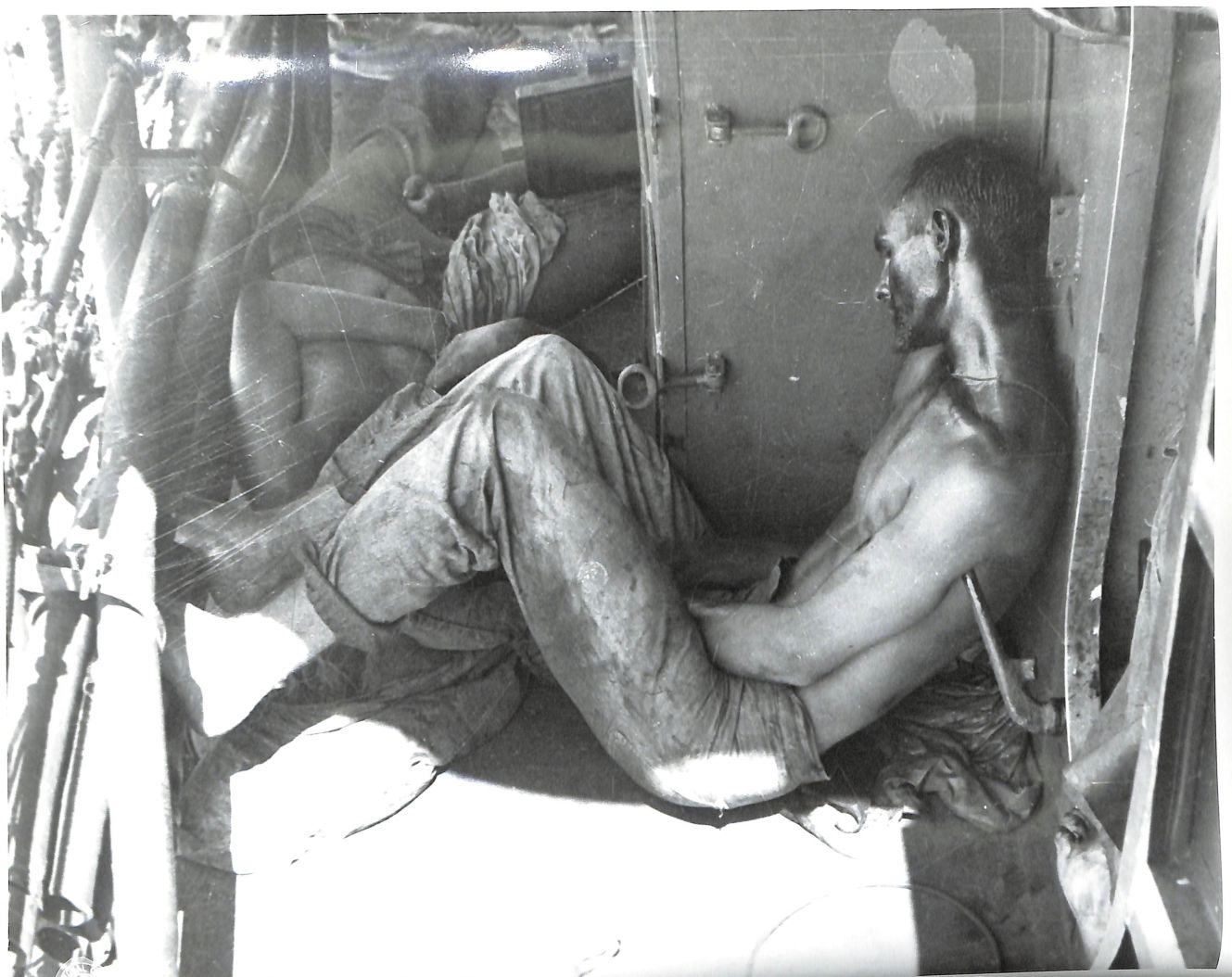
Zf766. A survivor/survivors of the Navy ships Gambier Bay, Hoel, Johnston, and Roberts is/are rescued. This is a NARA image.
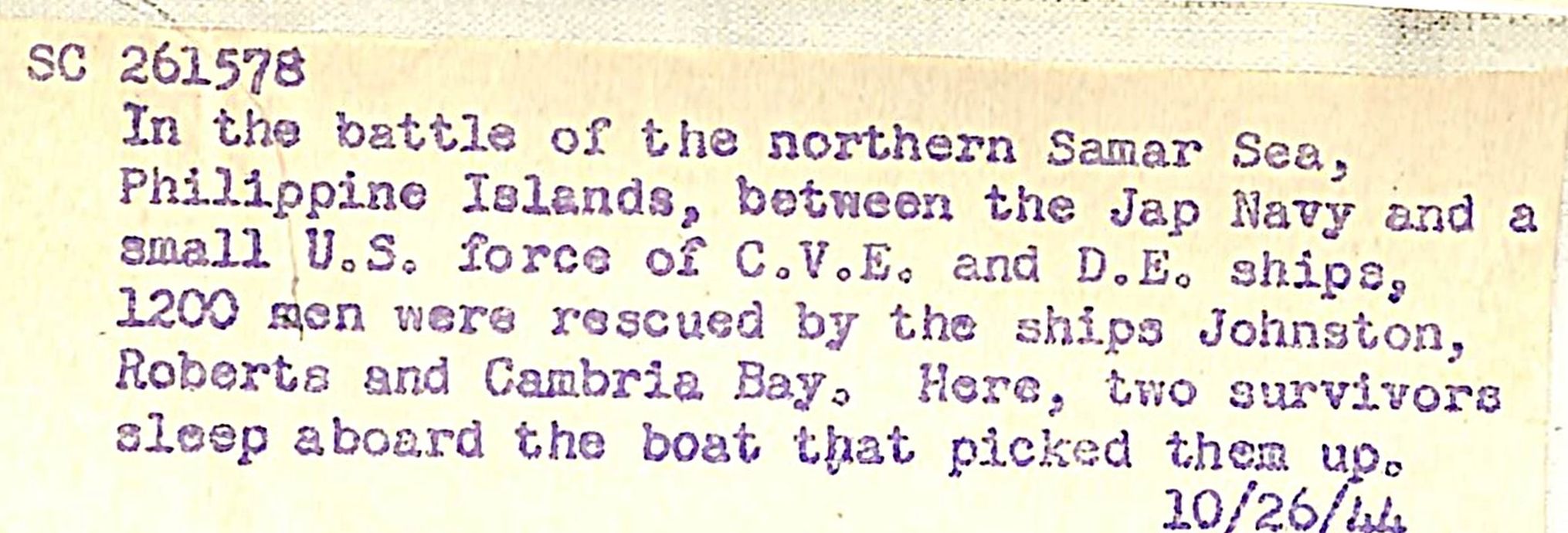
Zf767. These two images are the description of the previous image.

Zf768. These two images are the description of the previous image.
Johnston continued to take hits from the Japanese, which knocked out the number one gun mount, killing many men. By 09:20, forced from the bridge by exploding ammunition, Evans commanded the ship from the stern by shouting orders down to men manually operating the rudder. Shellfire knocked out the remaining engine, leaving Johnston dead in the water at 09:40. Her attackers concentrated their fire on her rather than the fleeing carriers. Johnston was hit so many times that one survivor recalled “they couldn’t patch holes fast enough to keep her afloat.”
At 09:45, Evans finally gave the order to abandon ship. Johnston sank 25 minutes later with 186 of her crew. Evans abandoned ship with his crew, but was never seen again. He was posthumously awarded the Medal of Honor. As the Japanese destroyer Yukikaze cruised slowly nearby, Robert Billie and several other crewmen saw her captain salute the sinking Johnston.[30]
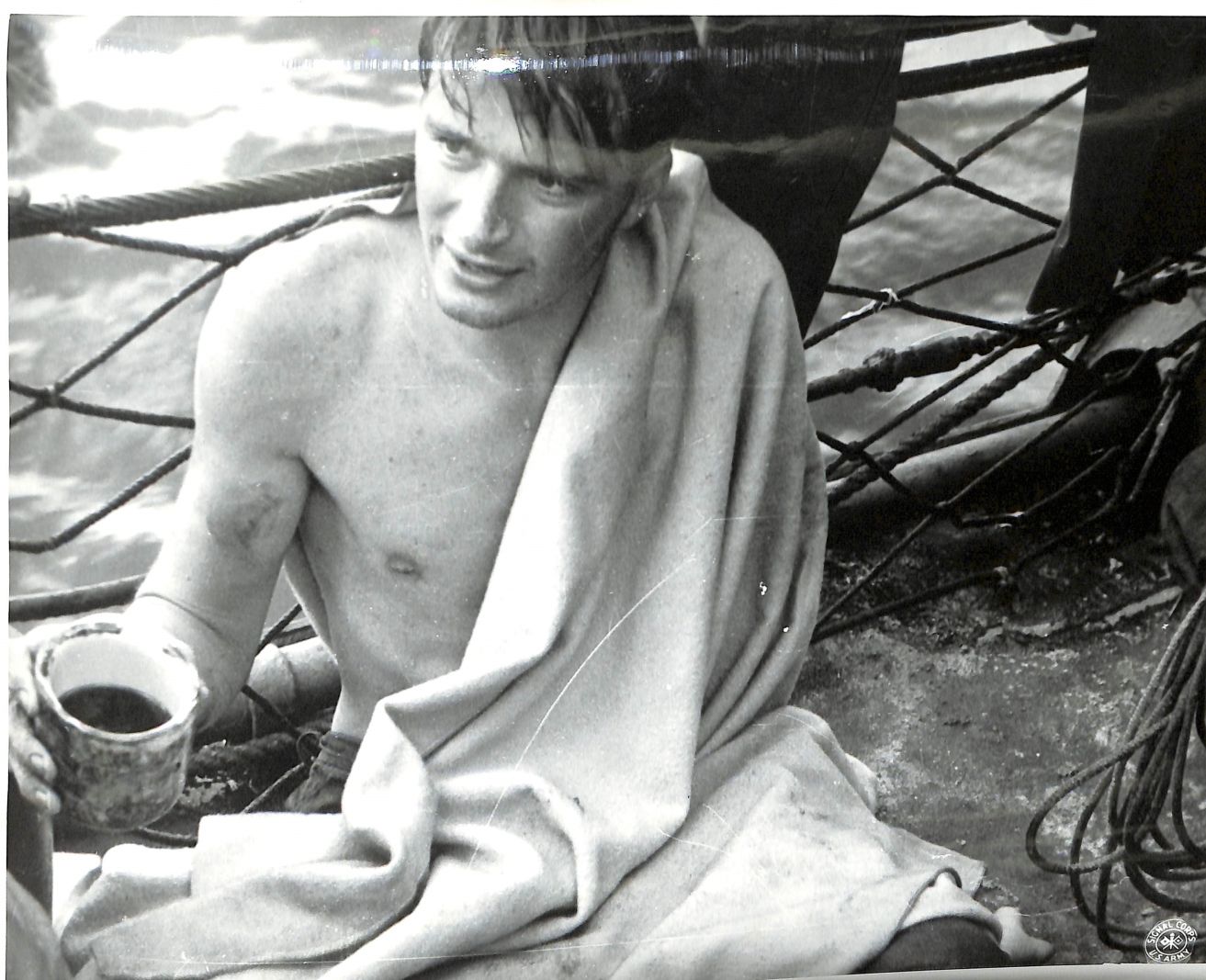
Zf772. A survivor/survivors of the Navy ships Gambier Bay, Hoel, Johnston, and Roberts is/are rescued. This is a NARA image.
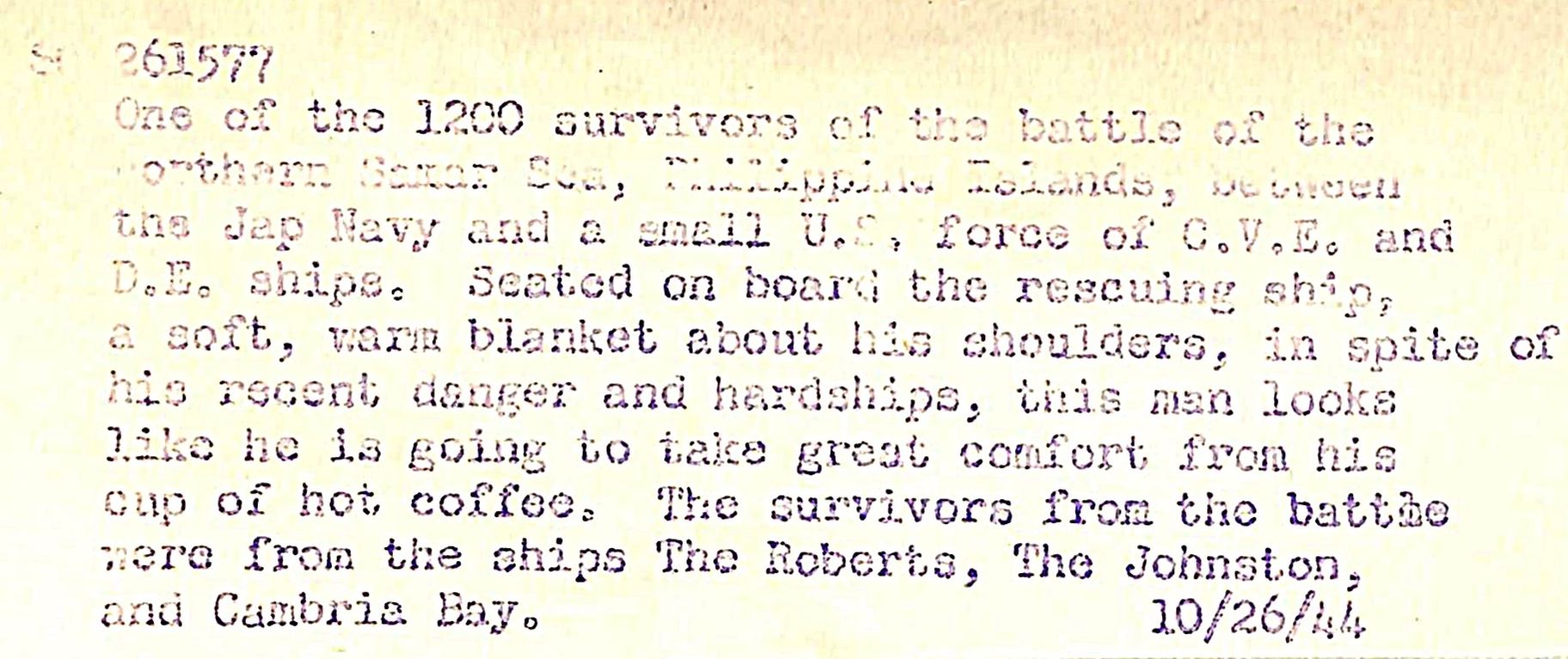
Zf773. This is the description of the previous image.
Gunner’s Mate Paul H. Carr was in charge of the aft 5-inch (127 mm) gun mount, which had fired nearly all of its 325 stored rounds in 35 minutes before a breech explosion caused by the gun’s barrel overheating. Carr was found dying at his station, begging for help loading the last round he was holding into the breech.[37] He was awarded a Silver Star, and the guided-missile frigate USS Carr (FFG-52) was later named for him. The guided-missile frigates Samuel B. Roberts (FFG-58) and Copeland (FFG-25) were named for the ship and its captain.
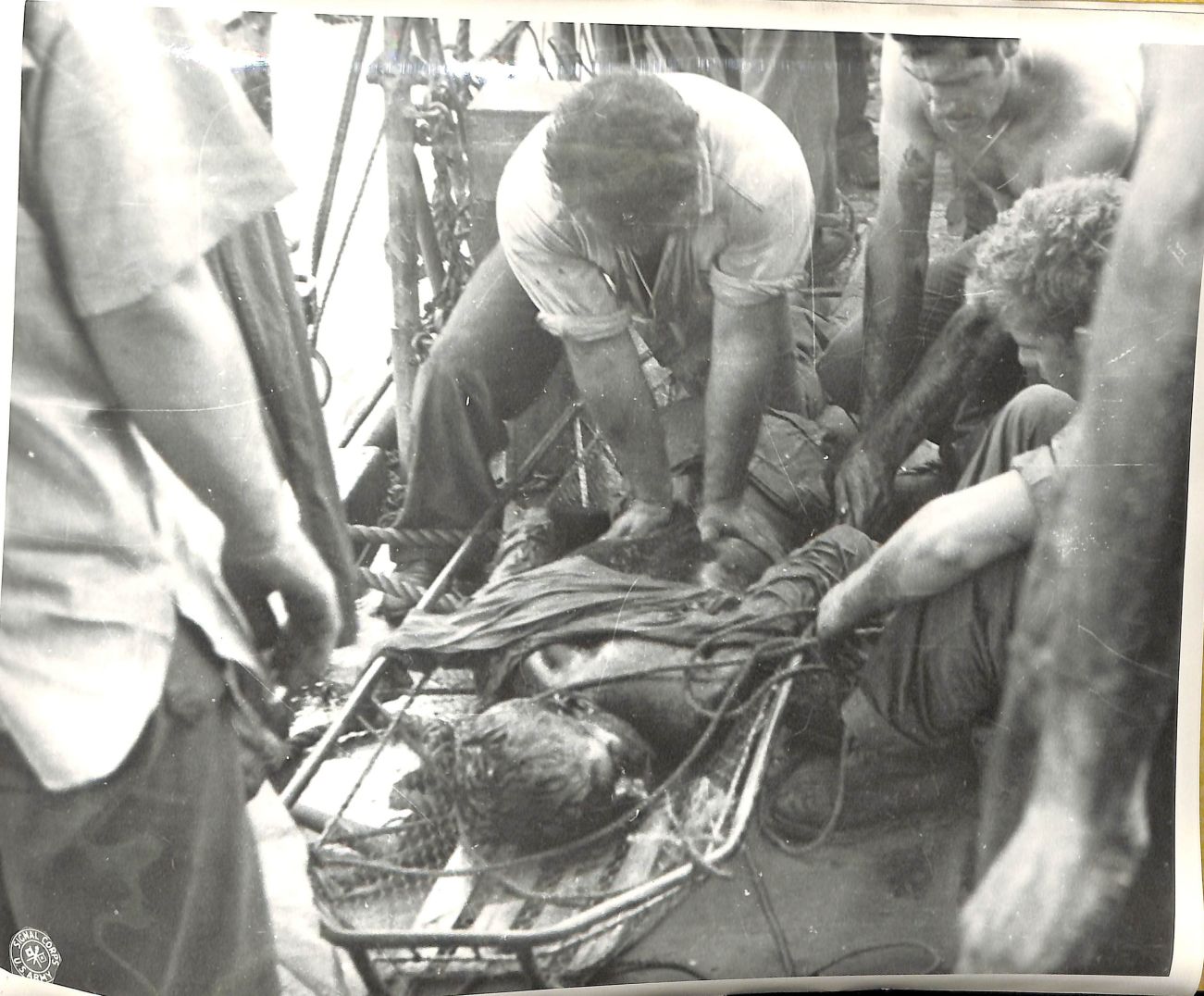
Zf774. A survivor/survivors of the Navy ships Gambier Bay, Hoel, Johnston, and Roberts is/are rescued. This is a NARA image.

Zf775. This is the description of the previous image.
Seventh Fleet’s calls for help
Shortly after 08:00, desperate messages calling for assistance began to come in from Seventh Fleet. One from Vice Admiral Thomas C. Kinkaid, sent in plain language, read, “My situation is critical. Fast battleships and support by airstrikes may be able to keep enemy from destroying CVEs and entering Leyte.”
At 08:22, Kinkaid radioed, “Fast Battleships are Urgently Needed Immediately at Leyte Gulf”.[68]
At 09:05, Kinkaid radioed, “Need Fast Battleships and Air Support”.
At 09:07, Kinkaid broadcast what his mismatched fleet was up against: “4 Battleships, 8 Cruisers Attack Our Escort Carriers”.
Clifton Sprague, the commander of Task Unit 77.4.3 in the battle off Samar, was later bitterly critical of Halsey’s decision and of his failure to inform Kinkaid and the Seventh Fleet clearly that their northern flank was no longer protected:
In the absence of any information that this exit [of the San Bernardino Strait] was no longer blocked, it was logical to assume that our northern flank could not be exposed without ample warning.

Zf776. A survivor/survivors of the Navy ships Gambier Bay, Hoel, Johnston, and Roberts is/are rescued. This is a NARA image.

Zf777. This is the description of the previous image.
In his master’s thesis submitted at the U.S. Army Command and General Staff College, Lieutenant Commander Kent Coleman argues that the division of command hierarchies of the Third Fleet, under Halsey reporting to Admiral Nimitz, and Seventh Fleet, under Vice Admiral Kinkaid reporting to General MacArthur, was the primary contributor to the near-success of Kurita’s attack. Coleman concludes that “the divided U.S. naval chain of command amplified problems in communication and coordination between Halsey and Kinkaid. This divided command was more important in determining the course of the battle than the tactical decision made by Halsey and led to an American disunity of effort that nearly allowed Kurita’s mission to succeed.
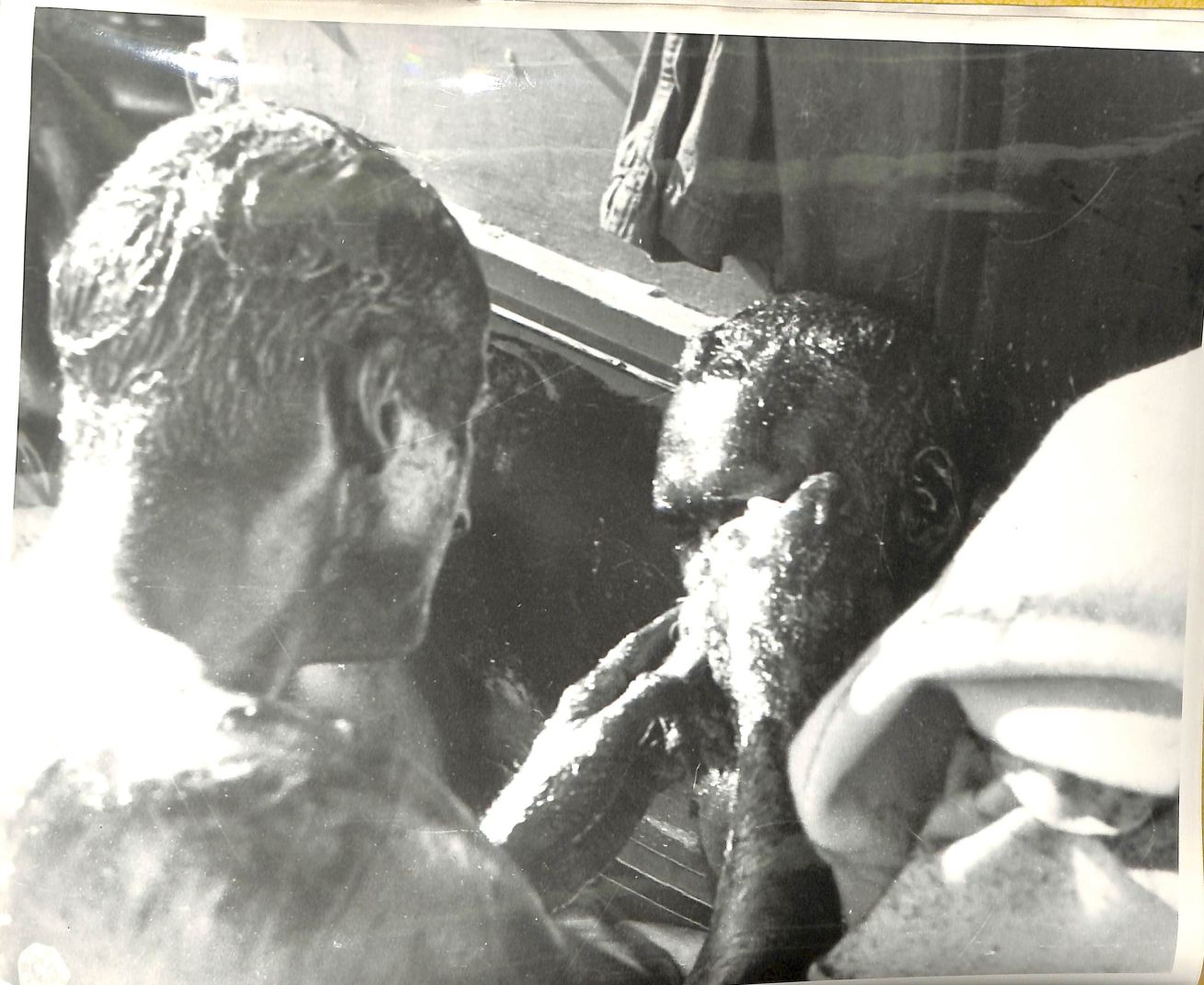
Zf778. A survivor/survivors of the Navy ships Gambier Bay, Hoel, Johnston, and Roberts is/are rescued. This is a NARA image.

Zf779. This is the description of the previous image.
Taffy 3 was awarded a Presidential Unit Citation:
For extraordinary heroism in action against powerful units of the Japanese Fleet during the Battle off Samar, Philippines, October 25, 1944. … the gallant ships of the Task Unit waged battle fiercely against the superior speed and fire power of the advancing enemy, … two of the Unit’s valiant destroyers and one destroyer escort charged the battleships point-blank and, expending their last torpedoes in desperate defense of the entire group, went down under the enemy’s heavy shells as a climax to two and one half hours of sustained and furious combat. The courageous determination and the superb teamwork of the officers and men who fought the embarked planes and who manned the ships of Task Unit 77.4.3 were instrumental in effecting the retirement of a hostile force threatening our Leyte invasion operations and were in keeping with the highest traditions of the United States Naval Service.[90]